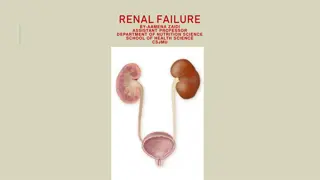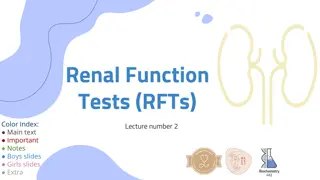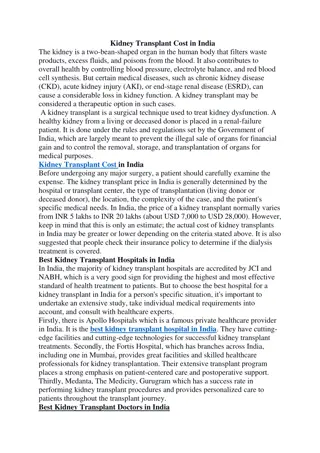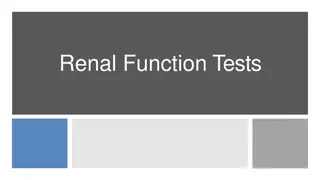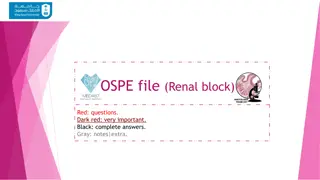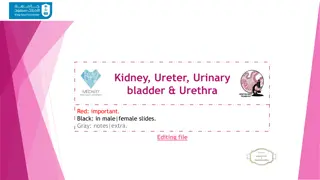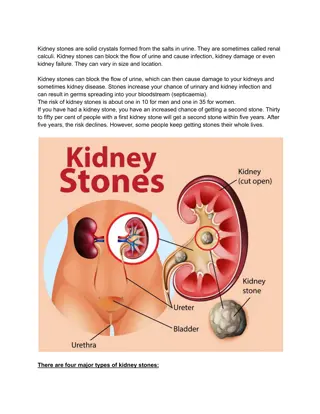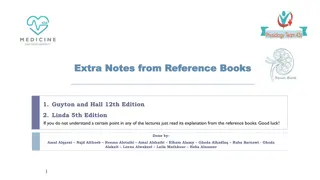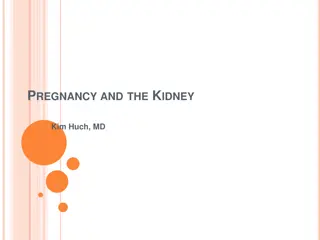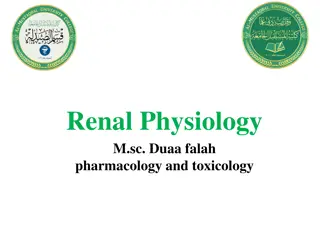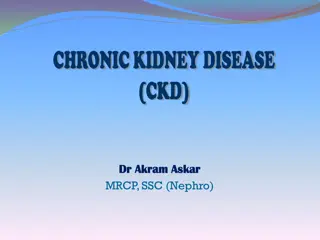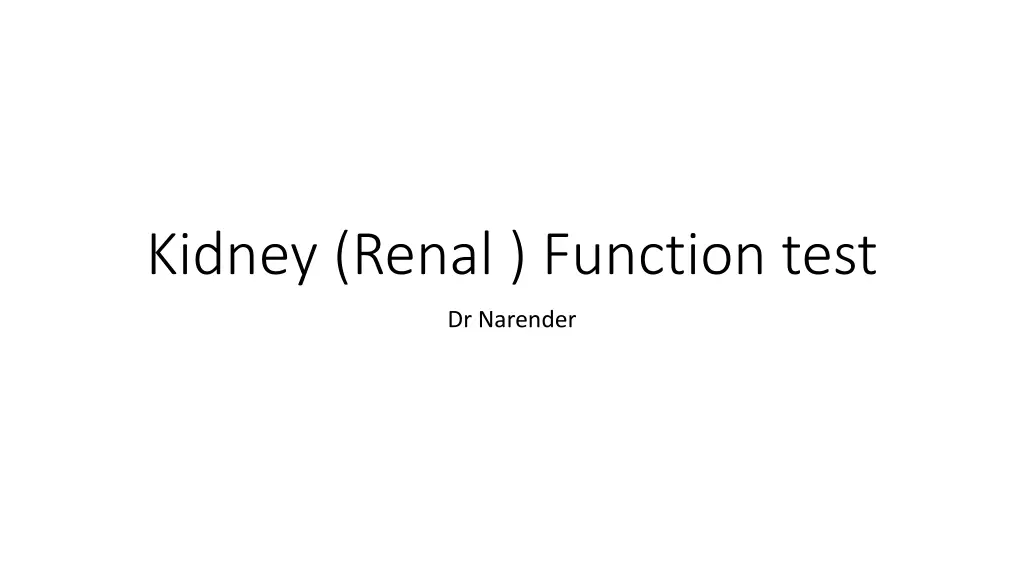
Understanding Renal Function Tests and Kidney Health
Learn about the renal function test conducted by Dr. Narender to assess kidney health. Explore the functions of the nephrons, glomeruli, tubular part, and collecting duct in the kidney. Understand the significance of key substances in urine and the concept of tubular maximum. Discover the early signs of abnormal kidney function and how the kidney filters blood.
Download Presentation

Please find below an Image/Link to download the presentation.
The content on the website is provided AS IS for your information and personal use only. It may not be sold, licensed, or shared on other websites without obtaining consent from the author. If you encounter any issues during the download, it is possible that the publisher has removed the file from their server.
You are allowed to download the files provided on this website for personal or commercial use, subject to the condition that they are used lawfully. All files are the property of their respective owners.
The content on the website is provided AS IS for your information and personal use only. It may not be sold, licensed, or shared on other websites without obtaining consent from the author.
E N D
Presentation Transcript
Kidney (Renal ) Function test Dr Narender
-The functional unit of kidney is known as nephrons -Which has glomerular and tubular and collecting duct -Glomerulus act like sieves, it is tuft of capillaries -Its main function is filtration: protein and cell free filtrate -When the blood is perfused through the Bowman s capsule , an ultra filtrate of the blood is produce in glomerulus , while the cells and proteins are retained in the blood -The sieves of the glomeruli are such that hemoglobin (mol wt 67,000) is passed through; while albumin (mol wt 69000 D) is retain in the blood Therefore earliest manifestation of the abnormal function of glomeruli is The appearance of albumin in urine
Functions of tubular part of kidney: Its main functions are Secretion and reabsorption Normal Glomerular filtration rate is about 120-125ml per minute It Mean about 120X60X24=172800 ml/day is blood filtered but urine excreted per day is about 1-1.5 l/day PCT 70% of water and sodium chlorides 100% glucose ,amino acids and potassium is absorbed
Threshold value of some common substances excreted through urine Glucose= 180mg/dl Lactate=60mg/dl Bicarbonate=28mg/dl Calcium=10mg/dl The maximum reabsorptive capacity of the substance is known as the Tubular maximum or Tm Tm for glucose is 375mg/min
1. To screen for kidney disease a. Complete urine analysis b. Serum urea and Creatinine 2. To asses renal function: a. To assess Glomerular function - Glomerular filtration rate - Clearance test: Creatinine, urea and Inulin 3. To asses tubular function test: urine specific gravity - Urine concentration & dilution test - Urine acidification test
Routine urinalysis Physical examination Volume:1-1.5 L/day Appearance : Clear: Normal urine is straw colored Cloudy/opalescent: Presence of pus cause cloudiness Yellow: Bilirubinuria in jaundice, B-complex intake Smoky red: Presence of blood Red: Porphyria Black urine: Alkaptonuria
Abnormalities detected in dipstick Abnormalities detected in dipstick Test and normal range Interpretations Specific gravity 1-005-1-025 Low-Renal tubular dysfunction, diabetes insipidus High-inadequate water intake, volume depletion pH 5.5-6.5 Low= high protein diet and acidosis High= low protein diet blood Stone Protein Fever, nephrotic syndrome Glucose Diabetes mellitus Ketone bodies Uncontrolled Diabetes mellitus, starvation Billirubin Hepatitis, obstructive jaundice Urobilinogen Hepatitis Bile salt Obstructive jaundice Nitrate UTI, Fever
Common test to assess kidney function test constituent Blood level or urine excretion Factors affecting urinary excretion Urea B=15-40 mg/dl U=15-30 g/day Dietary proteins, Protein catabolism Renal blood flow Creatinine B= 0.7-1.4 mg/dl (M) B= 0.6-1.3 mg/dl U= 1-2 g/day GFR, Tubular secretion, Age. Sex Body mass Uric acid B= 3-7 mg/dl (M) B= 2-5 mg/dl (F) Purine catabolism Tubular excretion Sodium B= 135-142 mmol/L Dietary sodium. renal function, State of hydration,diueretics Potassium B= 3.5-5 mmol/L Dietary potassium, Acid base balance Renal function calcium B=9-11mg/dl Dietary calcium, renal, PTH, Calcitonin
Advantages: 1. Extra renal factors will rarely interfere 2. Conversion of creatine phosphate to Creatinine is spontaneous 3. As the production is continuous , the blood level will not fluctuate. Blood can be collected at any time 4. It is not affected by diet or exercise Disadvantages: Creatinine is filtered by glomeruli and actively excreted by the tubules
Serum Creatinine GFR Adult male 0.7 1.4 mg/dl 95-115ml/minute Adult female 85-110ml/minute 0.6 1.3 mg/dl children 0.5-1.2mg/dl Creatinine clearance is most sensitive indicator of renal disease Its serum values are not affected by protein diet While serum urea level is affected by protein diet
The urea clearance is less the GFR, because it is partially reabsorbed Normal value is about 75-95 ml/minute
Inulin clearance is equal to GFR Neither secreted nor reabsorbed It is a polymer of fructose Drawback : test need continuous infusion of Inulin It is practically more convenient to estimate clearance of a substances already present in blood, for this reason creatinine is preferred over inulin clearance
Diodrast clearance test: known as di-iodo pyridone acetic acid It is a contrast medium used in taking X-ray of urinary tract Para-aminohippuric excretion test: PAH clearance test is measure of the renal blood flow Value is 1200 ml of blood/min or 700ml plasma/minute GFR is 125 ml/min Means 1/5 renal blood is brought to glomeruli becomes the glomerular filtrate this is called as filtration fraction
To assess tubular functions Urine concentration and dilution test Measuring urine specific gravity (SG) provide useful information about tubular function and hydration Acidification test Phenolsulphonphthalein (PSP) excretion test Para-animo Hippurate (PAH) clearance test
Urine concentration test: One of the earliest manifestation of renal tubular damage is the inability to concentrate the urine The first three morning sample of urine are collected after overnight fast If specific gravity exceeds 1.022 in at least one sample Its implies that ability to concentrate urine is intact Tubular function considerdnormal
Urine dilution test: Test is done in the morning, after overnight food and water deprivation. The bladder is emptied in morning A water load is given (1200 ml, within 30 minute) and urine samples are collected every hours for the next 4 hours. In normal subjects, most of the water load will be eliminated within these 4 hours and SG of at least one sample should fall to 1.003 or less If SG of all samples is above 1.003, it indicates impairment of tubular function The dilution test is more sensitive than the concentration test
Phenolsulphonphthalein (PSP) excretion test PSP not filtered by glomeruli but secreted by proximal renal tubules. PSP excretion in urine is used to test the efficiency of the tubular secretory capacity The patient is fasted overnight and asked to drink two glasses of water in the morning (to ensure adequate urine output) and empty the bladder after 15 minutes. This is followed by an IV injection of 6 mg of PSP in 1 mL solution. Urine is collected after 15, 30, 60, and 120 minutes after the injection and the amount of PSP in each sample is measured. In a normal subjects,20% - 25% of the injected dose should be excreted within 15 minutes and 60%-70% should be excreted within the first 2 hrs The test effectively detects early stages of renal tubular damages
PARA-AMINO HIPPURATE (PAH) CLEARENCE TEST Renal clearance of PAH equals renal plasma flow (RPF) This is because this analyte is completely filtered by the glomeruli and extensively secreted in tubules so much so that the entire PAH present in blood is removed by the kidneys in a single passage
Acidification test The capacity of the kidneys to produce acidic urine is studied following stimulation by ammonium chloride The subject is imposed an overnight fast but is encouraged to drink water till 8 am. Bladder is emptied and ammonium chloride, 0.1 g/kg, in gelatin-coated capsules is given orally Bladder is emptied and this sample discarded All the urine specimens passed during the next 6 hours are collected In healthy persons, urine pH falls below 5.3 in one of the specimens and total ammonia excretion is between 30 and 90 mEq/minute In renal failure, pH falls in the same way but ammonia excretion is low In renal tubular acidosis, the pH remain between 5.7 and 7.0 and the ammonia excretion is also low
Immunological test in renal disease Complement components Immunoglobulins and serum electrophoresis for paraproteinemias Cryoglobulins Ant-glomerular basement membrane antibody Free light chain assay with kappa: lambda ratio


